In Search of ‘Hospitable’ Grounds
In ‘Development in the Ecological Age’, Charles Eisenstein describes the narrative of development as a colonialist one, which ‘devalues the existing lifeways of people around the world and seeks to conform them to the image of the dominant power.’1 The support systems put in place to ‘help’ developing countries, such as financial grants and loans from the Global North/West, are simply meant to make local resources available to global capital. By the use of cheap labour those resources are monetised and those countries are left with huge debts. Likewise, the construction of material infrastructure such as pipelines, railways and structures for the extraction of natural resources, provides colonial instruments for the demarcation of territories, turning the soil into profitable land. These are violent processes of exclusion through which property comes into being under the logic of ‘improvement’.2 Such parts of these structures as are visible on the land are only the tip of the iceberg, signalling the presence of a far more complex system of material flows, labour, politics and environmental issues. They physically form territory by removing earth and making holes, piles and roads, layering the landscape while also expanding geopolitically via the flows of material, production and exploitation that feed urbanisation and development, comprising a network of structures in which the Earth figures as an indefinite resource for feeding the modern agenda. But the failures of the care-less project of development and of innovation as the dominant paradigm have left the planet requiring ‘critical care’, and in a state of ecological crisis.3 We need to stand, at this critical point, and ask: What is to be done beyond the modern project of development? How can we slow down and ultimately put an end to the unbridled project of modernity? What could be imagined and how can we live instead of exhausting and consuming the planet? What other stories could be told in lieu of those of progress and development?
In the ecological turn of architectural practices, the call to respond to the nexus of environmental, social and political crises has become urgent.4 It is no longer just a marketing term, like ‘sustainability’, but a compulsion under which practitioners have to work and rethink not only how to put an end to further harm to this planet, but also how to repair the damage already imposed on it. It is in this context that infrastructure architecture comes into focus, as these are the structures that connect or disconnect, exhaust or invigorate, care for or violate our planet. The characterisation of infrastructure in this discussion is twofold: it concerns both the colonizing aspects of infrastructure and the decolonizing potential of infrastructure and infrastructural thinking. The former is characterised by the Western-dominated logic of development and advancement that, in Brian Larkin’s words, is formed through ‘technopolitics’, here understood as ‘forms of political rationality that underlie technological projects and which give rise to an apparatus of governmentality’.5 The latter, on the other hand, tries to connect us to the Earth, not as a resource to be consumed but as a ground to cohabit; to be protected, taken care of and helped to flourish. Instead of thinking of infrastructure that consumes and exhausts the Earth’s resources in support of urbanisation, decolonising infrastructure tries to create hospitable grounds where the singular grand narrative of modernity is challenged by the thousand ways of being that in Arturo Escobar’s terms are ‘pluriversal’.6 In conversation with Escobar, Gustavo Esteva says that ‘development is radically inhospitable: it imposes a universal definition of the good life and excludes all others.’7 As a challenge to ‘development’ he suggests the word ‘hospitality’, and continues: ‘We need to hospitably embrace the thousand different ways of thinking, being, living, and experiencing the world that characterise reality.’8 Thinking through hospitality stretches our imagination to find ways of putting this broken world that has become a blasted landscape back together.
Acting within the existing obsolete and dysfunctional political and social structures that consistently fail to respond to environmental and social challenges, decolonising infrastructure moves from the question of ‘how the world is breaking down’ to that of ‘how the world gets put back together’.9 In the radical process of putting the broken pieces back together, a novel interdisciplinary and transdisciplinary practice of infrastructure architecture can take shape that will address the questions of the grounds of action and design methods, imagining a world that can be lived and organised differently. In this broken world, despite the limited natural resources, ‘failure is a raw, limitless field of value’, as Keller Easterling writes in her text ‘A Losing Game: Harnessing Failure’.10 The failure of the modern project of development in the age of petroleum-based industry has left the planet in a climatic crisis and has increasingly extended the ‘sacrifice zones’ from places far from the centres of so-called civilisation to everywhere on this planet.11 In this situation of omnipresent failure, mass migration due to climate change and to the crisis of capitalism, Easterling proposes that engaging with failure could unveil a new global geography of value. The practice of repair as an emergent tendency, in response to failure at the ‘intersection of politics, ecology and economy’,12 could challenge the idea of human-centred development.
Sludge
This short text is part of an ongoing series of experiments called Oily Stories that is in search of imagining a hospitable ground and decolonising infrastructure. Oily Stories tells decolonising stories of oil, set in ecologies shaped by oil. Situated mostly in the Gulf region and the Iranian context,13 the series works with the materiality, history and politics of oil and its encounters with different materials, environments, structures, bodies and political forces. In the manner of oil, these stories are leaked; they spill out of the infrastructure of petroleum, flow over boundaries and expand their environmental, political and social effects by polluting the grand narratives, ‘white geology’,14 and other subjugating forces. As part of this project, ‘Sludge’ specifically challenges the modern project of ‘development’ through forms of both textual and visual storytelling, using oil sludge as a starting point and metaphor for being stuck in a petroleum-driven world. Oil sludge is created when oil is mixed with soil and dust – basically, when it leaks out of petroleum infrastructure. Being stuck in sludge refers to how deeply interwoven with our lives oil has become: it even flows in our veins, due to the foods and medicines we take that are produced in connection to the petroleum industry. At the same time, the pollution, waste, global warming and environmental crisis form another metaphoric sludge that doesn’t allow us to move on: a massive sign of the failure of the modern project that started with the discovery of oil through colonisation. Following Easterling’s idea of using failure as the raw material for envisioning a new world, ‘Sludge’ addresses the broken infrastructure of oil as well as the unwanted side effects of the petroleum industry, imagining how a world beyond petroleum is to be constructed from these failures and flaws. The theoretical framework of these stories follows Walter D. Mignolo’s decolonial work of ‘de-linking’ from coloniality and ‘re-existing’ beyond colonial logic.15 A decolonised world is imagined to be a world beyond petroleum, free from the burdens of oil politics, wars, terrorism, dictatorship, colonisation, environmental crisis and forced migration: a hospitable ground.
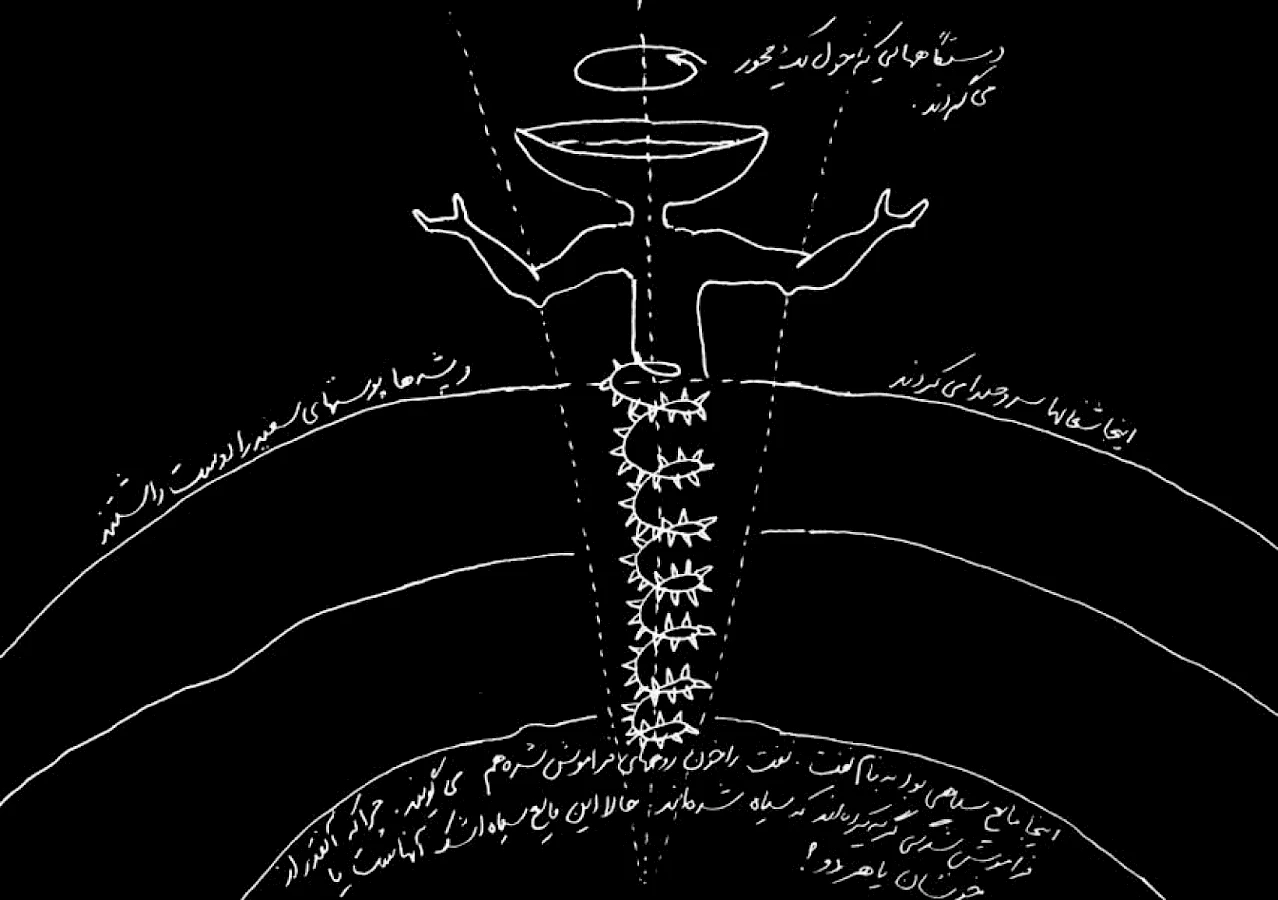
The Goddess of Oil (drawing by Sepideh Karami, 2020).

The Goddess of Oil (drawing by Sepideh Karami, 2020).
The project imagines an underground infrastructure that takes shape and grows to clean the world of petroleum and thereby repair the planet. Underground there are goddesses of oil, protagonists of the story who wait for failures of the modern project represented by petroleum waste, leaking pipelines, oil pits, and other failed infrastructure which oil leaves to meet the soil, absorbing, collecting and restoring the leaked oil to its original loci in-between the strata of the Earth. By removing the oil from the surface of the planet, they delink life from oil; delinking from the colonial narrative as the narrative of flawless modernity.
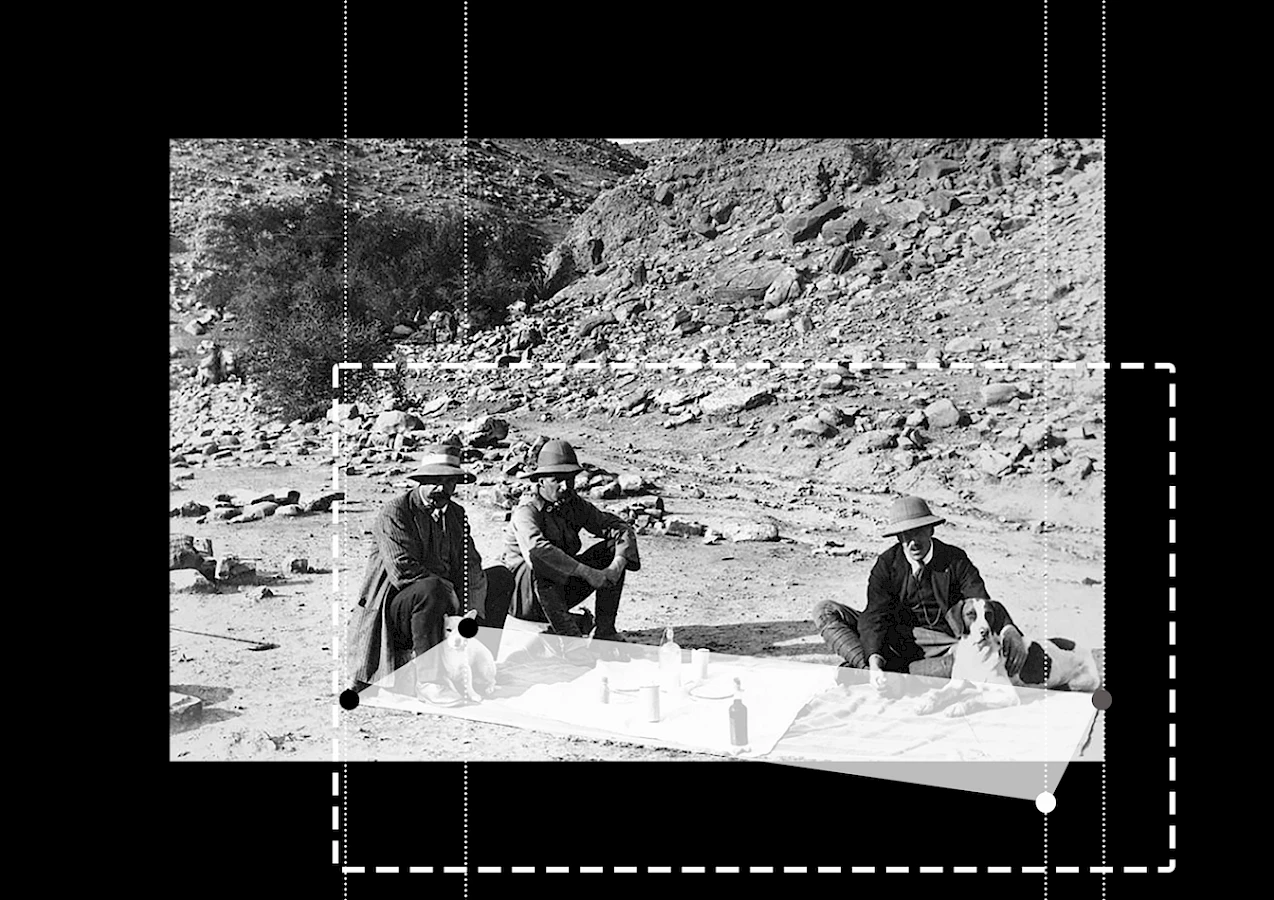
A diagram of claiming land and its resources (drawing by Sepideh Karami, 2021). The original photograph shows oil mining “pioneers” in the Middle East, having picnic near Masjed Soleyman, Iran 1900.
1. Pipes
To arrive at oil one needs to cross the deserts. The oil as lubricant of war machines turns the deserts into a battlefield, a terrain for galloping machines of colonialism, both living and non-living; for hyper-consumers of capitalism, and radical jihadis.16 The oil gives birth to these foreign characters of deserts: for both jihadis and colonizers, the horizontality of the desert should be preserved. The former does so by the removal of vertical terrestrial idols, the latter by the invention of pipelines as collapsed phallic idols. Pipelines are forms of infrastructure that guarantee the flow of energy and capital by preventing encounters between oil and earth. They prevent formations of sludge, mess and dirt to ‘ease [the] narration’ of colonialism,17 to optimise profit and to deny the Indigenous, among other exploited human and nonhuman inhabitants of these ancient deserts. Underneath the deserts, under where the pipes cross there are goddesses of oil collecting that which leaks out of the pipes.
There is a carpet in the middle of a desert. The carpet notates a place of discovery, giving orientation to a plane only known to the Indigenous people. They are absent in this photo, ignored in the narrative of oil discovery. They used to use trees, stones, winds, mountains and hills, rocks, sunrises and sunsets to orient themselves while moving about in the planes. In the picture, geologists are having a picnic. There is a bottle of some sort of dark liquid on the corner of the tablecloth. Under the carpet there is soil, earth, stones.
If you cut through the photograph and cut a deep section through the earth you will arrive in an in-between space where the pressure has created a world of black liquid creatures. The goddess of oil is summoning the oil back into the earth. She is summoning all the ghosts that are wandering around the troubled oil sites.
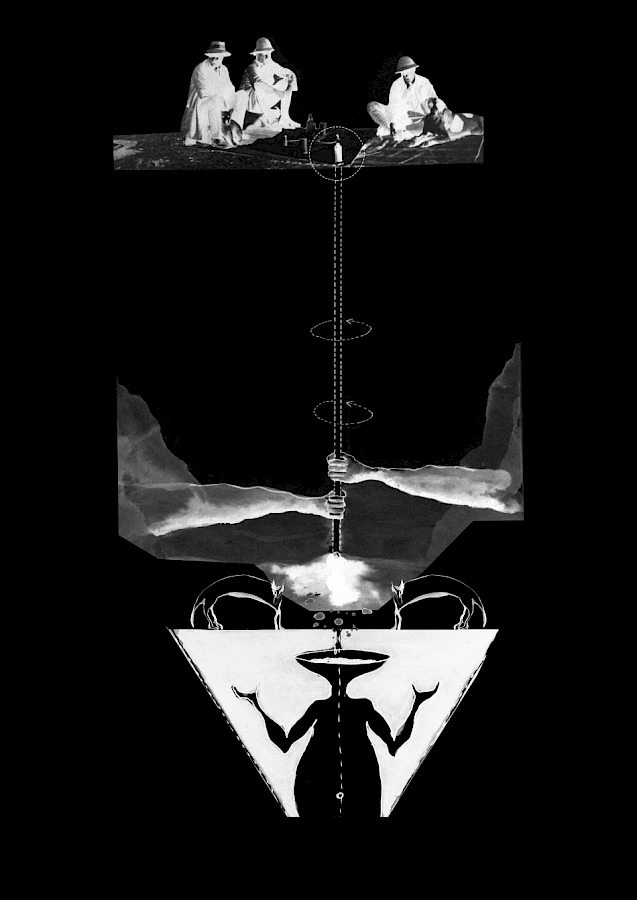
The Goddess of Oil, collecting and restoring oil underground (collage by Sepideh Karami, 2020).
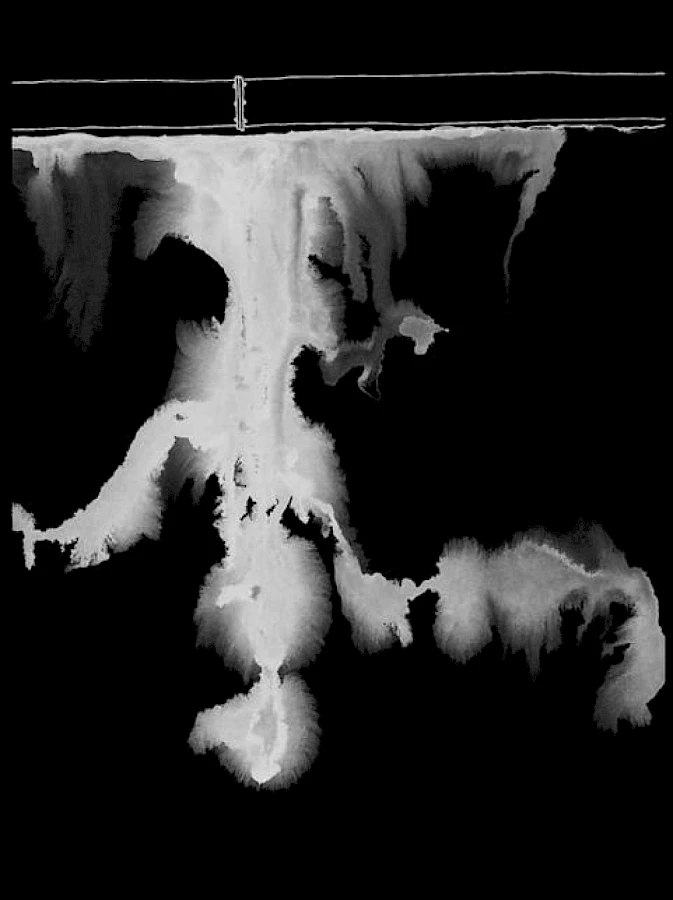
Broken oil pipes (drawing by Sepideh Karami, 2020).

The Goddess of Oil is collecting leaked oil from broken pipes (drawing by Sepideh Karami, 2020).
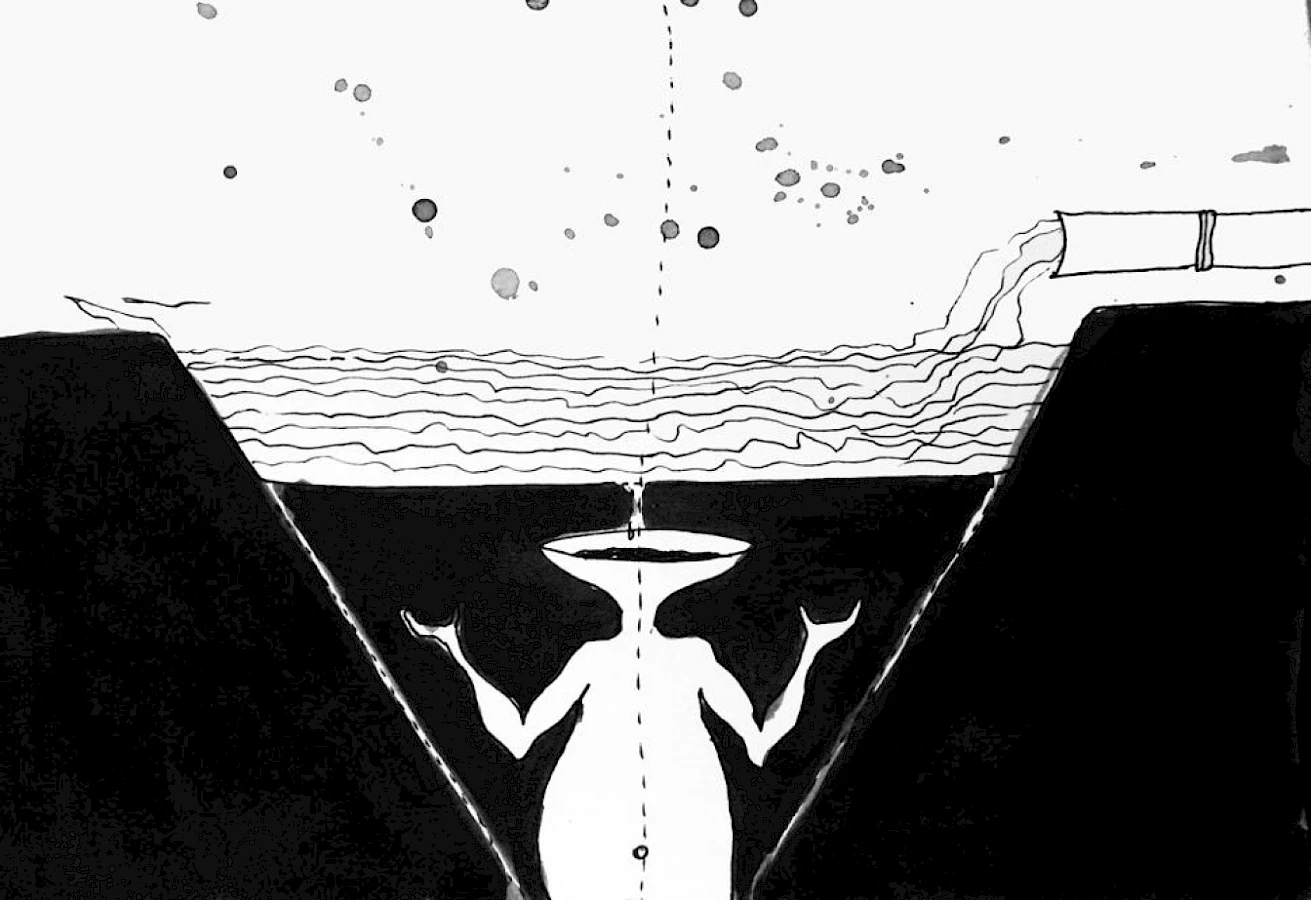
The Goddess of Oil collecting oil from leaking oil pits (drawing by Sepideh Karami, 2020).
2. Crude Oil Stone
This is a crude oil stone, invented to protect, to cherish and to dump waste. A mock-up of Earth, the original habitat of oil, it is a piece of stone that holds oil waste in its heart. When the stone absorbs and holds enough oil waste, it closes. It becomes heavy, burdened with dark stories of wars, pollution, deaths and lives. When it closes, it remains silent. If you want to re-listen to the stories, you should shake it. Then the words mix, sounds change. A new language is created.
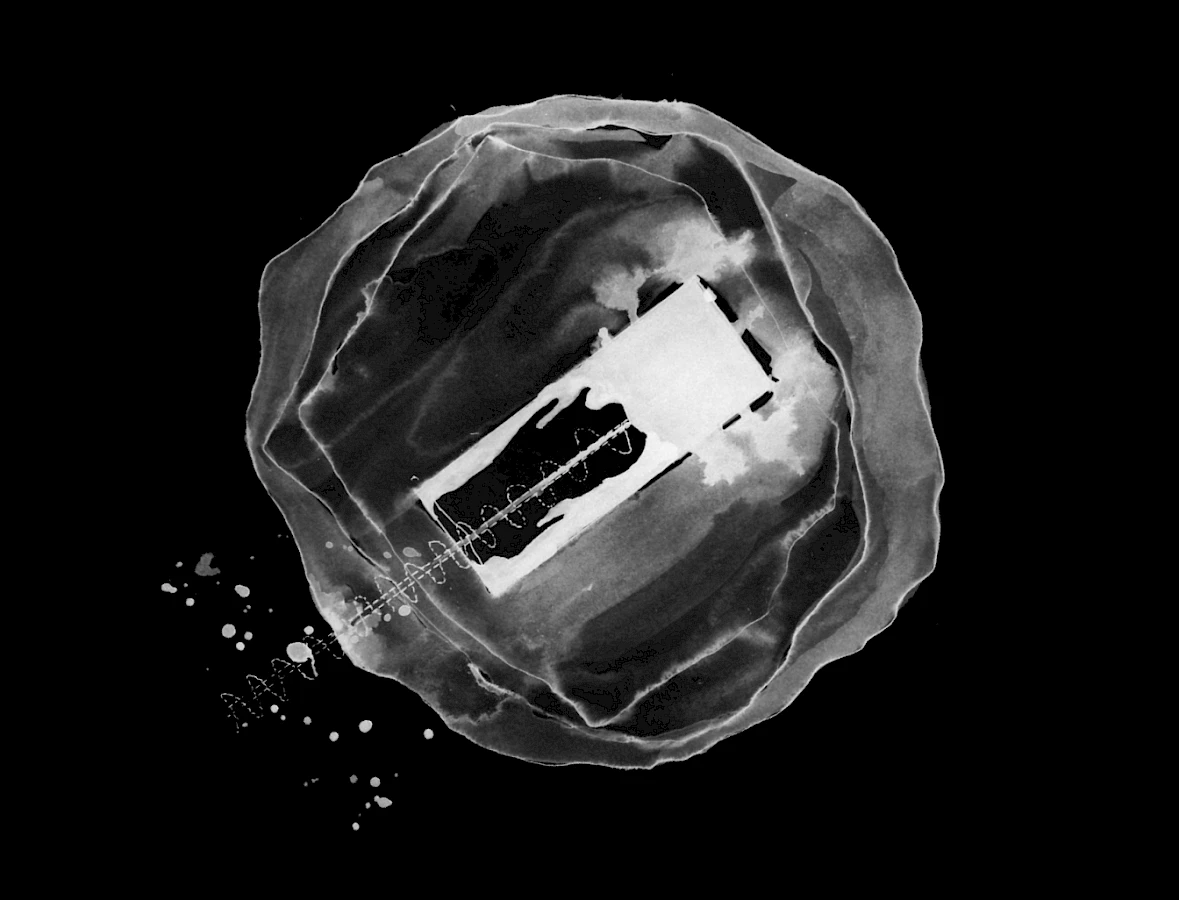
Crude Oil Stone for storing oil waste (drawing by Sepideh Karami, 2020).
Charles Eisenstein, ‘Development in the Ecological Age’, Kosmos Journal for Global Transformation, Spring/Summer 2014, kosmosjournal.org (accessed 29 January 2019).
Malini Ranganathan, ‘Property, Pipes, and Improvement’, POWER, 16 July 2019, power.buellcenter.columbia.edu (accessed 17 July 2019).
The term ‘critical care’ refers to Critical Care: Architecture and Urbanism for a Broken Planet (ed. Angelika Fitz, Elke Krasny and Architekturzentrum Wien), Massachusetts: MIT Press, 2019.
India Block, ‘RIBA declares climate emergency saying it is architecture’s “biggest challenge”’, Dezeen, 28 June 2019, dezeen.com (accessed 12 August 2021).
Brian Larkin, ‘The Politics and Poetics of Infrastructure’, Annual Review of Anthropology, no. 42, 2013, p. 328.
See Arturo Escobar, Pluriversal Politics: The Real and the Possible (trans. David Frye), Durham: Duke University Press, 2020.
Gustavo Esteva, ‘Postdevelopment @ 25: On “Being Stuck” and Moving Forward, Sideways, Backwards, and Otherwise’, in Arturo Escobar, Pluriversal Politics: The Real and the Possible, p. 101.
Ibid.
Shannon Mattern, ‘Maintenance and Care’, Places Journal, November 2018, placesjournal.org (accessed 22 November 2018).
Keller Easterling, ‘A Losing Game: Harnessing Failure’, The Architectural Review, 4 February 2019, architectural-review.com (accessed 4 February 2019).
See ‘Let’s Talk About Sacrifice Zones,’ Climate Reality Project, 13 May 2021, climaterealityproject.org (accessed 22 July 2021).
Valeria Graziano and Kim Trogal, ‘Repair matters’, Ephemera Journal (ed. Valeria Graziano and Kim Trogal), vol. 19, no. 2, 2019, p. 203, ephemerajournal.org (accessed 22 November 2021).
Another episode in this series, Those Planktons was exhibited at All Art Now Lab in Stockholm in April 2021 as part of the ‘Troubled Home’ project curated by Maryam Omrani. This episode comprised two video installations and a series of drawings and texts that together made a performance ground for the plankton to speak and tell stories of oil upon.
Kathryn Yusoff, A Billion Black Anthropocenes or None, Minneapolis: University of Minnesota Press, 2018, p. 4.
Walter D. Mignolo, ‘Coloniality Is Far From Over, and So Must Be Decoloniality,’ The University of Chicago Press Journal, 2017, journals.uchicago.edu (accessed 26 November 2021).
Reza Negarestani, Cyclonopedia: Complicity with Anonymous Materials, Melbourne: re.press, 2008, p. 19.
Ibid.
The views and opinions published here mirror the principles of academic freedom and do not necessarily reflect the views or positions of the L'Internationale confederation and its members.